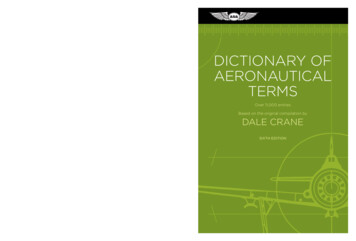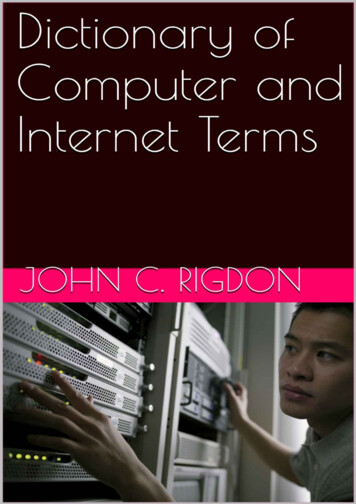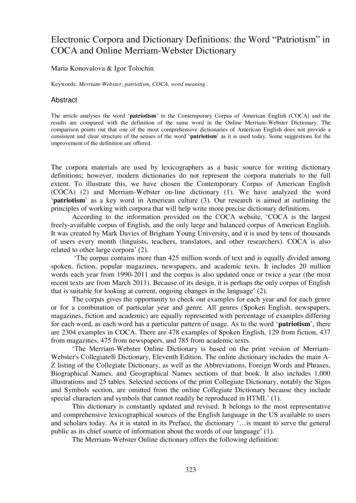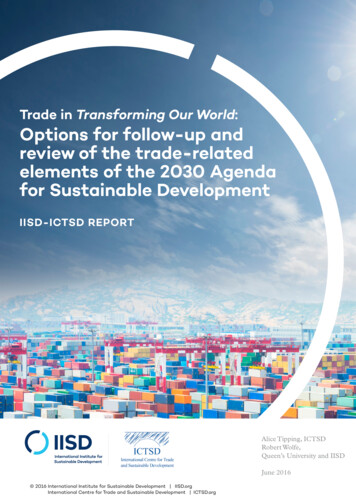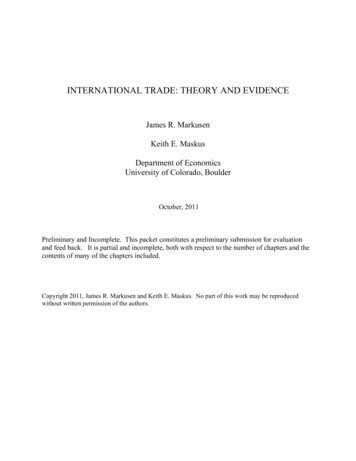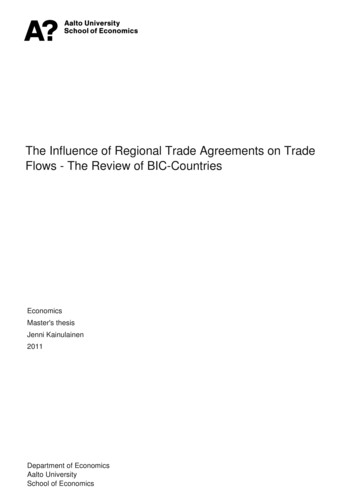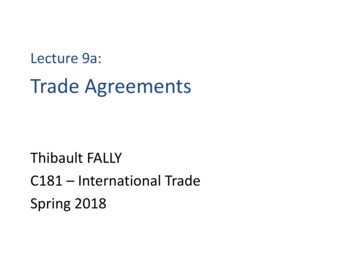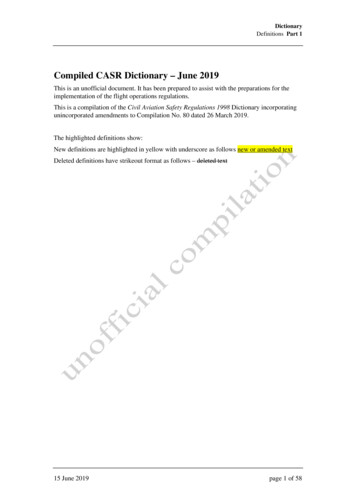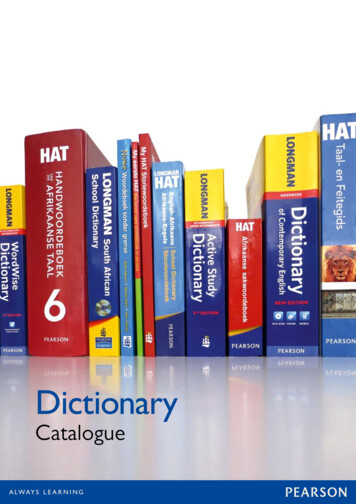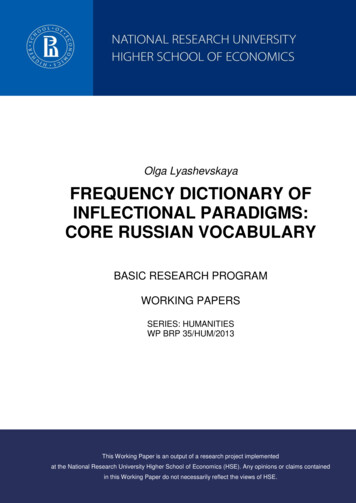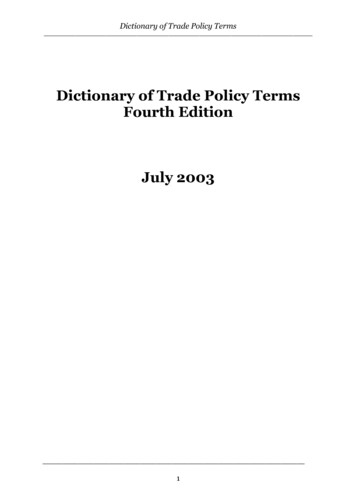
Transcription
Dictionary of Trade Policy �——–Dictionary of Trade Policy TermsFourth EditionJuly 20031
Dictionary of Trade Policy �——–Disclaimer:Dr Walter Goode is an officer of the Australian Department of Foreign Affairsand Trade (DFAT). The explanations, definitions and comments expressed inthis volume do not reflect the views of DFAT or those of the AustralianGovernment. These may be found in departmental and Autralian Governmentstatements and publications.Any views given in this dictionary on WTO agreements, provisions, panel andAppellate Body reports, or any other information provided by the WTO, are thesole responsibility of the author, and do not necessarily represent the views ofWTO Members, the WTO Secretariat, or the Appellate Body Secretariat. Assuch, the definitions in this dictionary do not constitute authoritativeinterpretations of the legal texts of the WTO and are presented for illustrativepurposes only.2
Dictionary of Trade Policy �——–PrefaceThis is the fourth edition of the Dictionary of Trade Policy Terms. With eachedition it has grown. The number of entries is now close to double that in thefirst edition. Apart from adding words, I have used this opportunity to updateand otherwise revise many of the entries in the third edition.The previous three editions were published by the Centre for InternationalEconomic Studies at the University of Adelaide. Professor Kym Anderson, thehead of the Centre, first suggested to me that there would be a market for adictionary of this kind. His judgement was sound. Earlier versions of thedictionary have now also been published in Chinese, Korean and Vietnamese.Professor Anderson remains closely associated with this project.This edition appears under the combined imprint of Cambridge UniversityPress, the World Trade Organization (WTO) and the Centre for InternationalEconomic Studies. I am rather pleased about this.I cannot compete with the trade policy expertise residing in the WTO. Still, Itake satisfaction from having been able to contribute to making the world oftrade policy more accessible to a broad public.I would like to thank the WTO for permission to use in its entirety a glossaryprepared by its officers for the Doha Ministerial Conference. Though I havebenefited from the work being done by the WTO, the contents of thisdictionary are of course independent of it.This is a dictionary of trade policy terms. It lists topics routinely dealt with bytrade officials in trade negotiations. It is not a dictionary of internationaleconomics. The areas of the two disciplines overlap in some cases, but thedistinction between them is clear. Trade policy consists of a mixture ofeconomics, law and politics, with the latter two often the dominatinginfluences. International economics in comparison is much more rigorous.Even a brief look at textbooks of international economics suggests thateconomists are not always convinced of the validity of concepts used by tradenegotiators.The trade policy agenda continues to widen. Tariffs and non-tariff measuresremain central to international negotiations. Their reduction or eliminationremains a goal for many. The well-established trade rules, such as traderemedies, also continue to require attention.What is striking, however, is the extent to which the debate about the contentof trade negotiations has shifted to the problems developing countries3
Dictionary of Trade Policy �——–encounter in implementing existing commitments and, more broadly, thedesirable balance between the obligations of developed and developingcountries. The Doha Development Agenda is a clear symbol of this shift.On a broader scale, some suggest that new rules will be needed to clarify therelationship between trade rules and environmental measures. Othersquestion whether the existing framework of intellectual property rules isadequate for a truly globalising age, and whether broader rules might benecessary to recognize the creative abilities of societies in development.This edition of the dictionary takes account of these and other debates in thetrade arena. It now contains many entries that only a decade ago would havebeen considered the preserve of different spheres of activity.Entries are in alphabetical order, usually in their most common form.Examples are GATS for General Agreement on Trade in Services, KyotoConvention for the International Convention on the Simplification andHarmonization of Customs Procedures, UNCTAD for the United NationsConference on Trade and Development and CITES for the Convention onInternational Trade in Endangered Species of Wild Fauna and Flora. In eachcase I have also included the formal version of the entry, with a referral to themain entry.Entries are mostly self-contained, but in a few cases I thought it useful toduplicate partly an explanation under a different entry. Many entries containreferrals in italic bold to other entries. Readers should use these referrals asthey like. Occasionally they may find something in this way that they hadforgotten or didn’t know. References to the WTO are so frequent that thereseemed little need to provide a cross-reference when they occur.Some entries are longer than is customary in dictionaries. Some areunquestionably longer than they should be. Still, I think that the reader shouldbe offered, for example, a small historical survey of important concepts like themost-favoured-nation principle, the place of developing countries in themultilateral trading system or major events like the Kennedy or the TokyoRounds. Some entries are idiosyncratic, or at least the reader will think, with adeal of justification no doubt, that they are. That, I am afraid, is in the natureof books.Other entries are purely or largely historical. Among these are the AtlanticCharter, the Havana Charter, the Global Negotiations, the Marshall Plan, theHaberler Report and the United Nations Conference on Trade andEmployment. One thing these entries do, however, is to show how persistentsome of the problems of international trade policy are, and how hard it can beto find solutions for them.4
Dictionary of Trade Policy �——–This dictionary contains some greatly abbreviated accounts of disputesbrought before the GATT, and one or two before heard before the WTO. Nodictionary of trade policy could be complete without a mention of hatters’ furor Belgian family allowances. Those seeking further details on these and otherdisputes should consult the Basic Instruments and Selected Documents (theBISD) for GATT disputes and, for example, the Dispute Settlement Reportspublished by Cambridge University Press or the relevant WTO documents onwww.wto.org for more recent disputes.I am greatly indebted to John Croome, formerly a senior officer with the GATTSecretariat, who read the entire text. He commented on many entries andsuggested some new ones. His long experience with the multilateral tradingsystem and his willingness to share his knowledge have made the dictionary abetter book. He has also saved me from several embarrassing mistakes. I am ofcourse solely responsible for any remaining mistakes.I would also like to thank two anonymous referees. Their comments havepointed out gaps and inaccuracies in the text. I have dealt with these to thebest of my ability.Jean-Guy Carrier of the World Trade Organization has done everything tobring this edition out on time. I would like to thank him for that.I again would like to acknowledge the support I have had from my colleagues.John McCarthy, Australian Ambassador in Tokyo, and Peter Grey, DeputySecretary in the Department of Foreign Affairs and Trade, have encouraged mein various ways to keep the selection of terms relevant and up to date. JustinBrown, James Baxter, Simon Twisk, Lisa Filipetto and Elizabeth Young allhave engaged me in debates about trade policy and its language. I am gratefulfor their interest in this book.I am also grateful to Wendy Zweck of the Centre for International EconomicStudies for her administrative support for this project.It is obvious that I have benefited from the efforts of many, but theresponsibility for any errors of fact, inadequate interpretation or infelicitousexpressions is entirely mine.WGNovember 20025
Dictionary of Trade Policy �——–AAbsolute advantage: an idea described by Adam Smith in his Inquiry intothe Nature and Causes of the Wealth of Nations, and developed further byothers, that countries engage in international trade to obtain goods morecheaply from abroad than they could make them themselves at home. Smithargued that international trade allows a greater specialization than would bepossible in an autarkic system, thereby permitting resources to be usedmore efficiently. Writing about the reasons why families buy things ratherthan making them themselves, he said: “What is prudence in the conduct ofevery private family can scarce be folly in that of a great kingdom. If aforeign country can supply us with a commodity cheaper than we ourselvescan make it, better buy it with some part of the produce of our own industryemployed in a way in which we have some advantage.” See also autarky,comparative advantage, gains-from-trade theory, HeckscherOhlin theorem, self-reliance and self-sufficiency.Absolute standard: see minimum standard of treatment.Accelerated tariff liberalization: ATL. The APEC initiative for earlyvoluntary sectoral liberalization in another guise. APEC ministersdecided in Kuala Lumpur in November 1998 to transfer the tariff elementsof the first nine sectors of this initiative to the WTO. The nine sectors areforest products, fish and fish products, toys, gems and jewellery, chemicals,medical equipment and instruments, environmental goods and services,energy, and a telecommunications mutual recognition agreement. In theAuckland Challenge APEC members agreed to pursue the intiative untilthe end of 2000.Acceptable level of risk: defined in the WTO Agreement on theApplication of Sanitary and Phytosanitary Measures as "the levelof protection deemed appropriate by the Member establishing a sanitary orphytosanitary measure to protect human, animal or plant life or healthwithin its territory”. This concept is also known as the “appropriate level ofsanitary or phytosanitary protection”. See also sanitary andphytosanitary measures.Accession: the act of becoming a member of the WTO (World TradeOrganization), or another international Organization or agreement.Accession to the WTO requires negotiations between the existing membersand the applicant to ensure that its trade regime will be in harmony withWTO rules and that the applicant is able to observe these rules. Onaccession, the schedules of tariffs and services commitments the newmember offers should also be comparable to those of existing memberswhich have participated in successive rounds of multilateral tradenegotiations and reduced their trade barriers over the years. In other6
Dictionary of Trade Policy �——–words, a country has to be prepared to offer roughly the same as it will enjoyfrom membership. Accession to the OECD requires new members to showthat their economic regime is broadly in tune with those of existingmembers. Membership of UNCTAD or other United Nations bodies doesnot entail this sort of obligation. See also enlargement, schedules ofcommitments on services and schedules of concessions.Access to Medicines: an aspect of work on intellectual property rightsin the WTO. It deals with the balance between obligations under theAgreement on Trade-Related Aspects of Intellectual PropertyRights (TRIPS) and the expectations of developing countries for affordablemedicines. Developing countries claim that compulsory licences andparallel imports are essential for their governments to carry out effectivehealth policies through affordable medicines. In their view, the TRIPSagreement is skewed in favour of developed countries and thepharmaceutical companies residing there. The differing views on access tomedicines show the inherent tension between intellectual property rights (aform of monopoly rights) and public expectations of vigorous competitionbetween companies. The Declaration on the TRIPS Agreement andPublic Health adopted at the Doha Ministerial Conference is aimedat reducing this tension and at the same time maintaining the benefits ofadequate protection of intellectual property rights.Accounting rate: in telecommunications, the charge made by one country’stelephone network operator for transporting calls originating in anothernetwork to their final destinations within the second network. See alsotelecommunications termination services.ACP-EC Partnership Agreement: a framework for trade and economiccooperation between the ACP states (except Cuba) and the EuropeanCommunity which entered into force on 1 March 2000 for twenty years asthe successor to the Lomé Convention. It is based on five pillars: acomprehensive political dimension, participatory approaches to ensure theinvolvement of civil society in beneficiary countries, a strengthened focus onpoverty reduction, a framework for economic and trade cooperation and areform of financial cooperation. The Agreement has several reviewmechanisms. Its trade aspects will be renegotiated after eight years to makethem fully compatible with WTO obligations. During this time (called thepreparatory period) the European Community will give non-reciprocalpreferential access free of duty and charges to products from ACP states.Special provisions apply to some agricultural products, especially sugar.Support for national budgets in countries highly dependent on agricultureand/or mineral exports is available to ACP states if losses from exportearnings jeopardize overall macroeconomic stability. The Agreement entailswide-ranging cooperation in trade-related areas including, among others,trade in services, competition policy, trade and environment and trade andlabour standards. The parties have also undertaken to use the preparatoryperiod to remove progressively barriers to trade between them and topursue cooperation in all areas relevant to trade. See also ACP-EC7
Dictionary of Trade Policy �——–Protocol on Sugar and Special Preferential Sugar Agreements.ACP-EC Sugar Protocol: first concluded in 1975 as Protocol 3 to the LoméConvention. It is an instrument of indefinite duration. The Protocol is nowpart of the ACP-EC Partnership Agreement. Through this protocol theEuropean Community undertakes to purchase, at guaranteed prices,specific quantities of cane sugar, raw or white, originating in ACP states.The following annual quantities apply: Barbados (49,300 tonnes), Fiji(163,000 tonnes), Guyana (157,000 tonnes), Jamaica (118,300 tonnes),Kenya (5,000 tonnes), Madagascar (10,000 tonnes), Malawi (20,000tonnes), Mauritius (487,200 tonnes), Swaziland (116,400 tonnes) andTanzania (10,000 tonnes). See also Special Preferential SugarAgreement.ACP states: The African, Caribbean and Pacific states associated with theEuropean Community through the ACP-EC PartnershipAgreement which gives them preferential access to the EuropeanCommunity markets and other benefits. The group of ACP states wasestablished on 6 June 1975 through the Georgetown Agreement. It nowoperates under a revision of the Agreement agreed in November 1992. ItsGeneral Secretariat is located in Brussels. The members of the group areAngola, Antigua and Barbuda, Bahamas, Barbados, Belize, Benin, Botswana,Burkina Faso, Burundi, Cabo Verde, Cameroon, Central African Republic,Chad, Comoros, Republic of Congo, Democratic Republic of Congo, CookIslands, Côte d’Ivoire, Cuba, Djibouti, Dominica, Dominican Republic,Eritrea, Ethiopia, Fiji, Gabon, The Gambia, Ghana, Grenada, EquatorialGuinea, Guinea-Bissau, Guinea, Guyana, Haiti, Jamaica, Kenya, Kiribati,Lesotho, Liberia, Madagascar, Malawi, Mali, Marshall Islands, Mauritania,Mauritius, Federal States of Micronesia, Mozambique, Namibia, Nauru,Niger, Nigeria, Niue, Palau, Papua New Guinea, Rwanda, Saint Kitts andNevis, Saint Lucia, Saint Vincent and the Grenadines, Samoa, Sao Tome andPrincipe, Senegal, Sychelles, Sierra Leone, Solomon Islands, Somalia, SouthAfrica, Sudan, Suriname, Swaziland, Tanzania, Tanzania, Togo, Tonga,Trinidad and Tobago, Tuvalu, Uganda, Vanuatu, Zambia and Zimbabwe.Cuba is a member of the group of ACP states, but not a party to the ACP-ECPartnership Agreement.Acquis communitaire: all legislation adopted under the treatiesestablishing the European Communities, including regulations,directives, decisions, recommendations and opinions. Title I of theTreaty of Maastricht sets maintaining and building the acquiscommunitaire as one of the objectives of the European Union. When acountry accedes to the European Union, its national legislation needs to beharmonized with the acquis communitaire. This can mean revisinghundreds of parliamentary acts. See also enlargement and EuropeanCommunity legislation.Actionable subsidies: a category of subsidies described in the WTOAgreement on Subsidies and Countervailing Measures. Subsidiesmay be actionable, and therefore illegal, if they cause injury to the8
Dictionary of Trade Policy �——–domestic industry of another member, negate other commitments madeunder the GATT, or cause serious prejudice to the interests of anothermember. If such adverse effects exist, the country maintaining the subsidymust withdraw it or remove its adverse effects. See also countervailingduties, non-actionable subsidies, prohibited subsidies andsubsidies.Act of state doctrine: the principle expressed in a United States SupremeCourt judgement of 1897 that "every sovereign State is bound to respect theindependence of every other sovereign State, and the courts of one countrywill not sit in judgment on the acts of the government of another, donewithin its own territory". Other jurisdictions of course also use this doctrine.Adding-up problem: see fallacy of composition.Additional commitments: the GATS permits WTO members to makecommitments on trade in services that are additional to those made undermarket access and national treatment. Qualifications, standards andlicensing matters are mentioned specifically, but additional commitmentsneed not be confined to these areas. See also schedules of commitmentson services.Adjustment costs: the economic and social costs arising from structuraladjustment.Administered protection: see contingent protection and non-tariffmeasures.Administered trade: see managed trade.Administrative guidance: the practice of influencing the activities of anindustry by government ministries through through formal or informalmeasures. Guidance may simply consist of advice on how to interpret agovernment act or decision. It may also be a method of enforcing, forexample, voluntary export restraints through the publication ofindicative production and export forecasts. Industries are then supposed towork out among themselves how to divide the export cake. Administrativeguidance of the second kind probably works best in countries where theenforcement of competition policy is weak.Administrative international commodity agreements: these areinternational commodity agreements that do not operate a bufferstock, export quotas or other mechanisms designed to influence theprice of a commodity through manipulating the amount coming on themarket. This type of agreement is concerned with matters such as markettransparency, more efficient production, processing and distribution,consumer information, and the collection and dissemination of statisticalinformation. See also economic international commodityagreements.Administrative protection: see contingent protection and non-tariffmeasures.Administrative regulation: see regulation.Ad notes: the notes and explanatory provisions contained in Annex I to theGATT. They amplify and interpret some of the GATT articles proper. They9
Dictionary of Trade Policy �——–always have to be read together with the relevant article.Ad referendum agreement: provisional acceptance of the outcome of a setof negotiations. Definitive acceptance may depend on the results of relatednegotiations, approval by the government or the fulfilment of some othercondition. See also bracketed language and without prejudice.Ad valorem equivalent: a calculation of the level of a specific tariff,which converts a rate expressed as a fixed monetary value per product into avalue expressed as a percentage of the value of the product. This gives thead valorem tariff rate. For example, a specific tariff of one dollar leviedon a compact disc worth ten dollars would give an ad valorem equivalent of10%. On a disc worth twenty dollars, a tariff of one dollar would amount to5%. See also compound tariff.Ad valorem tariff: a tariff rate expressed as a percentage of the value of thegoods to be imported or exported. Most tariffs are now expressed in thisform. See also customs valuation and specific tariff.Advance informed consent: an obligation embodied in the CartagenaProtocol on Biosafety. It establishes the need for an exporter to seekconsent from an importing country before the first shipment of a livingmodified organism intended for intentional release into theenvironment. See also prior informed consent.Advance ruling: binding advice by a competent authority on the legality ofan action or its impact before the action is taken. For example, Article 509 ofNAFTA requires the customs administrations of member countries to issuepromptly a written advance ruling on its tariff treatment of a good before itis imported. Importers and exporters alike may ask for such rulings.Advisory Centre on WTO Law: established on 17 July 2001 in Geneva asan independent intergovernmental organization with funding fromnine developed countries and more than 25 developing countries andeconomies in transition. The Centre provides legal services and training todeveloping countries and economies in transition that have contributed toits endowment fund. Least developed countries can use the Centre’sservices without contributing funds.African Economic Community: AEC. An organization aiming to promotethe economic, social and cultural development of Africa. It was establishedon 12 May 1994 through the Treaty of Abuja. Membership, which nowexceeds fifty, is open to all members of the Organization of African Unity,now the African Union. The AEC will aim in the long term to form anAfrican Common Market. In the medium term it will concentrate on tradecooperation and trade facilitation. Its secretariat is located in AddisAbaba.African Growth and Opportunity Act: AGOA. Part of the United StatesTrade and Development Act of 2000, valid until 30 September 2008. TheAct is based on a congressional finding that it is in the mutual interest of theUnited States and the countries of sub-Saharan Africa to promote stableand sustainable economic growth and development in sub-Saharan Africa.It gives sub-Saharan countries duty-free access to the United States for most10
Dictionary of Trade Policy �——–products. It also promotes the negotiation of free-trade agreements betweenthe United States and sub-Saharan countries. Countries must meet certaineligibility requirements to benefit from this Act. Among these are that thecountry (a) has established, or is making progress towards, a market-basedeconomy, (b) enjoys the rule of law and political pluralism, (c) is eliminatingbarriers to United States trade and investment, (d) has economic policies toreduce poverty, (e) has a system to combat corruption and bribery and (f)protects internationally recognized workers rights. Activitiesundermining United States national security or foreign policy interests andengaging in gross human rights violations or international terrorism make acountry ineligible for the benefits of this Act.African Union: established in July 2001 at a meeting in Lusaka of Africanheads of government as the successor to the Organization of AfricanUnity.AFTA: ASEAN Free Trade Agreement. A preferential agreement coveringtrade in goods among the ASEAN countries. AFTA entered into force on 1January 1993 and was realized for the six original signatories (BruneiDarussalam, Indonesia, Malaysia, Philippines, Singapore and Thailand) on 1January 2002. Vietnam participates in AFTA on a limited basis for the timebeing, but it will take on the full obligations by 2006. Burma and Laos,which joined ASEAN in July 1997, will fulfil their tariff reductioncommitments by 2008. The six original signatories extend tariff preferencesto the other four ASEAN members (Cambodia, Laos, Mynamar andVietnam) through the ASEAN Integration System of Preferences.Free trade under AFTA is assumed to be a tariff of up to 5%. The mainmechanism for the tariff reductions under AFTA is CEPT (CommonExternal Preferential Tariff). Goods traded preferentially are covered by theInclusion List. For goods on the Temporary Exclusion List thepreferential tariff will be phased in by 2003 at the latest. Tariff reductionsare expected to take rather longer for goods on the relatively smallSensitive List of unprocessed agricultural products adopted in December1995. Implementation of the new agricultural tariff reduction schedulesbegan on 1 January 1996. AFTA also has a work program for the eliminationof non-tariff measures. See also ASEAN Framework Agreement onServices and ASEAN Investment Area.AFTA-CER Closer Economic Partnership: a program of activitiesestablished in 2000 aimed at achieving closer economic integration betweenthe ASEAN countries, Australia and New Zealand.Agency for international trade information and cooperation: seeAITIC.Agenda 21: a program of principles and actions relevant to trade andenvironment adopted on 14 June 1992 by UNCED (United NationsConference on Environment and Development) in Rio de Janeiro. Programarea A seeks to promote sustainable development through trade. Itsobjectives are (a) to promote an open, non-discriminatory and equitabletrading system that will enable all countries to improve their economic11
Dictionary of Trade Policy �——–structures and improve the standards of living of their populations throughsustained economic development, (b) to improve access to markets forexports of developing countries, (c) to improve the functioning ofcommodity markets and achieve sound, compatible and consistentcommodity policies at national and international levels with a view tooptimizing the contribution of the commodity sector to sustainabledevelopment, taking into account environmental considerations, and (d) topromote and support domestic and international policies that makeeconomic growth and environmental protection mutually supportive. This isto be done through a range of activities described in general terms andinspired to some extent by traditional UNCTAD work on commodities.Program area B aims (a) at making trade and environment mutuallysupportive in favour of sustainable development, (b) to clarify the role ofGATT, UNCTAD and other international organizations in dealing withtrade and environment-related issues, including, where relevant,conciliation procedure and dispute settlement, and (c) to encourageinternational productivity and competitiveness and encourage aconstructive role on the part of industry in dealing with environment anddevelopment issues. These objectives are also supported by practicalactivities. Agenda 21 is mentioned in the terms of reference for the WTOCommittee on Trade and Environment as a text relevant for itsdeliberations. See also commodity policy, Rio Declaration onEnvironment and Development and World Summit onSustainable Development.Agenda 2000: the European Community financial reform plan for 200006 aimed at strengthening European Union with a view to receiving newmembers. The strategy identifies three main challenges: (a) how tostrengthen and reform the Union's policies so that they can deal withenlargement and deliver sustainable growth, higher employment andimproved living conditions for Europe's citizens, (b) how to negotiateenlargement while at the same time vigorously preparing all applicantcountries for the moment of accession, and (c) how to finance enlargement,the advance preparations and the development of the Union's internalpolicies. The strategy foresees major changes to the CommonAgricultural Policy since the envisaged eastward enlargement could leadto an increase of 50% in European Community agricultural land and adoubling of the farm labour force. See also Europe Agreements andTreaty of Nice.Aggregate measurement of support: a term used in agriculturalnegotiations. It is the annual level of support expressed in monetary termsfor all domestic support measures where government funds are used tosubsidize farm production and incomes. It includes product-specific supportand support given to agricultural producers in general. The annual level ofsupport has to be reduced as a result of the Uruguay Round negotiations.Domestic support measures with minimal impact on trade do not have to bereduced. See also Agreement on Agriculture, amber box, blue box,12
Dictionary of Trade Policy �——–equivalent measure of support, green box, subsidies and totalaggregate mesurement of support.Aggressive multilateralism: the option available to the United States ofusing the WTO dispute settlement mechanism vigorously, backed up bySection 301 to the extent that that would be legal or desirable.Aggressive reciprocity: the unilateral action of an economy which seeks toforce a trading partner to change its trade policy. Measures used includ
dictionary are of course independent of it. This is a dictionary of trade policy terms. It lists topics routinely dealt with by trade officials in trade negotiations. It is not a dictionary of international economics. The areas of the two disciplines overlap in some cases, but the distinction between them is clear. Trade policy consists of a .
